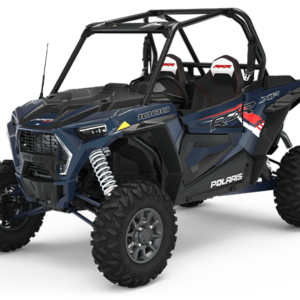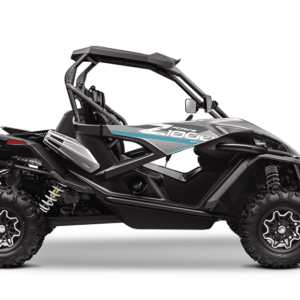When changing the oil and filter on your Polaris RZR XP 1000 or RZR XP 4 1000, always wear safety glasses and nitrile gloves. Always check and change the oil at the intervals outlined in the Periodic Maintenance Chart found in your Owner’s Manual. Always change the oil filter whenever changing oil. The PS-4 Oil Change Kit is part number 2879323. The Extreme Duty Oil Change Kit is part number 2879324.
Access the oil check dipstick through the right rear wheel well. Access the oil fill cap through the service access panel on the floor of the cargo box. The crankcase drain plug is located on the bottom of the crankcase. Access the drain plug through the access hold under the crankcase.
To change the oil and filter, do the following:
- Position the vehicle on a flat level surface.
- Place the vehicle in PARK.
- Start the engine. Allow it to warm up at idle for 2 to 3 minutes.
- Stop the engine.
- Remove the cargo box access panel.
- Remove any debris near the oil cap and remove the oil cap.
- Clean the area around the drain plug.
- Place a drain pan under the engine crankcase. Tip: Place a rag in the bottom of the drain pan to prevent the splashing of oil.
- Remove the drain plug with a 6mm Allen socket. Allow the oil to drain completely. Caution: Hot oil can cause burns to skin. Do not allow hot oil to contact skin.
- Remove the seats by pulling the lever at the back of the seat and pivoting forward to remove.
- With the seats out of the way, remove the oil filter access panel by pulling out and lifting straight up.
- Using a 2.5-inch (64mm) oil filter wrench, turn the filter (1) counter-clockwise to remove it.
- Using a clean dry cloth, clean the filter sealing surface on the crankcase. Make sure the old filter O-ring is completely removed.
- Lubricate the O-ring on the new filter with a film of fresh engine oil. Check to make sure the O-ring is in good condition.
- Install the new filter. Rotate it clockwise by hand until the filter gasket contacts the sealing surface, and then turn it an additional 3/4 of a turn. The oil filter for a RZR XP 1000 or RZR XP 4 1000 is part number 2540086. It is included in both oil change kits.
- Inspect the drain plug and sealing surfaces. Install a new sealing washer on the drain plug. The sealing washer is part number 5812232. Notice: The sealing surfaces on the drain plug and crankcase should be clean and free of burrs, nicks or scratches
- Clean the sealing surface and reinstall the drain plug. Torque to 12 ft-lbs (16 Nm).
- Wipe up any residual oil on the vehicle.
- Fill the engine with 2.5 quarts (2.4 liters) of oil through the oil fill cap. Your Polaris Oil Change Kit comes with the proper amount of oil.
- Reinstall the oil fill cap.
- Reinstall the cargo box access panel.
- Start the engine and allow it to idle for 1 to 2 minutes.
- Stop the engine and inspect for leaks.
- Check the oil level and add oil as needed to bring the level to the upper mark on the dipstick.
- Wipe up any residual oil that may have collected on vehicle components.
- Reinstall the oil filter access panel.
- Reinstall the seats by aligning the front tabs and pushing down on the rear.
- Dispose of the used filter and oil properly.
- In addition to changing the oil, make sure to grease the propshaft and clean the spark arrestor.
- Grease the prop shaft through the driver’s rear wheel well and under the center console.
- To remove the spark arrestor, loosen the spark arrestor fastener with an 8mm socket and pull the spark arrestor out to clean.
- Reinstall the spark arrestor and fastener. Torque to 8 ft-lbs (11 Nm).
Programmable Service Interval
The service interval counter on the instrument cluster of your RZR is programmed to 25 hours at the factory. As hours of engine operation increase, the counter decreases. The wrench icon will flash for about 10 seconds when the counter reaches zero and each time the key is turned on thereafter until the counter is reset.
When this feature is enabled, it provides a convenient reminder to perform routine maintenance. Refer to the recommended oil change intervals.
To reset or change the service interval:
- Press and hold the MODE (4) button to enter the settings menu.
- Press either toggle button (5) to cycle to the “Service Hours” option. Press MODE to select.
- Press MODE to reset the existing value and exit or press either toggle button to change the value. Press MODE to save and exit the settings menu.
For more information, see your authorized Polaris Dealer. To find a dealer near you, use the Dealer Locator.
Maintenance tips, procedures and specifications can be found in your Owner’s Manual.
To view diagrams or find replacement part numbers, use the online parts catalog.

